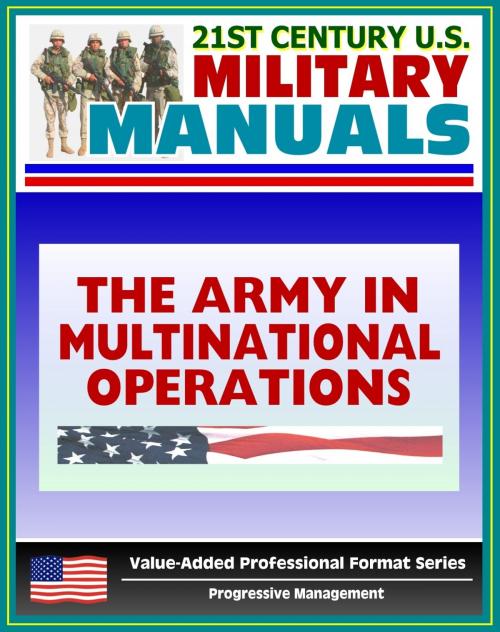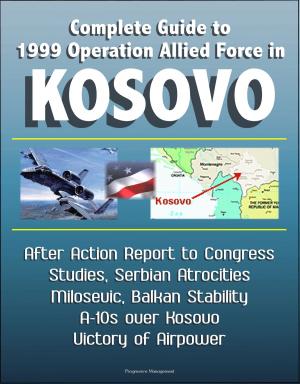21st Century U.S. Military Manuals: The Army in Multinational Operations (FM 100-8) Nations, Coalitions, Alliances in War and Peacekeeping (Value-Added Professional Format Series)
Nonfiction, Science & Nature, Technology, Military Science| Author: | Progressive Management | ISBN: | 9781465858252 |
| Publisher: | Progressive Management | Publication: | September 9, 2011 |
| Imprint: | Smashwords Edition | Language: | English |
| Author: | Progressive Management |
| ISBN: | 9781465858252 |
| Publisher: | Progressive Management |
| Publication: | September 9, 2011 |
| Imprint: | Smashwords Edition |
| Language: | English |
Professionally converted for accurate flowing-text e-book format reproduction, the Army in Multinational Operations Field Manual (FM 100-8) covers the fundamentals of multinational operations.
In the preface, it states:
"This manual is a guide for Army commanders and staffs operating in a multinational environment across the full range of military operations. This doctrine for multinational operations takes into account each type of operation and varying political objectives, force compositions, operating areas, and other factors. It also considers general similarities in most multinational operations. Because of the varying compositions and varying political objectives, consensus is extremely difficult to obtain for multinational operations. Harmonization of the multinational force is critical to ensure unity of effort. FM 100-8 blends key points of Joint Pub 3-16 into its approach to ensure consideration by Army elements of a joint force. This manual addresses the Army's roles and functions within a multinational operation; multinational leadership; command relationships, to include examples of possible command relationships; and, finally, the key functional planning considerations of the multinational commander at the operational and tactical levels of war."
Some highlights of the contents:
"Multinational operations include military forces from different nations. These operations are normally interagency operations. Conducting operations with foreign military partners, like operations with civilian partners, is uncommon to many soldiers, so a clear understanding of this different environment is necessary. US forces are increasingly more involved in United Nations (UN) operations and must plan accordingly. The majority of US peace operations will be part of a UN peace operation. Their multinational character merits particular attention because national interests and organizational influence may compete with doctrine and efficiency. Consensus is painstakingly difficult, and solutions are often national in character. Commanders can expect contributing nations to adhere to national policies and priorities, which at times complicates the multinational effort. UN-sponsored operations normally employ a force under a single commander. The secretary general appoints the force commander with the consent of the UN Security Council. The force commander reports either to a special representative of the secretary general or directly to the secretary general. While the force commander conducts day-to-day operations with fairly wide discretionary powers, he refers all policy matters to the special representative or secretary general for resolution. FM 100-23 is an excellent reference for UN operations. Multinational operations is the overarching collective term to describe military actions conducted by forces of two or more nations, typically within the structure of a coalition or alliance. If that operation takes place within the NATO or Combined Forces Command (CFC) in Korea, it is an alliance."
This manual is produced by Headquarters, US Army Training and Doctrine Command (TRADOC).
As a bonus, this reproduction includes FM-1, The Army Field Manual, a capstone manual containing the vision for the Army - sold separately for $5.99. FM 1 establishes the fundamental principles for employing Landpower. The most important of these are the Army's operational concept and the fundamentals that support it. They form the foundation for all Army doctrine. All Soldiers should understand and internalize them. FM 1 describes the American profession of arms, the Army's place in it, and what it means to be a professional Soldier.
This is a privately authored news service and educational publication of Progressive Management.
Professionally converted for accurate flowing-text e-book format reproduction, the Army in Multinational Operations Field Manual (FM 100-8) covers the fundamentals of multinational operations.
In the preface, it states:
"This manual is a guide for Army commanders and staffs operating in a multinational environment across the full range of military operations. This doctrine for multinational operations takes into account each type of operation and varying political objectives, force compositions, operating areas, and other factors. It also considers general similarities in most multinational operations. Because of the varying compositions and varying political objectives, consensus is extremely difficult to obtain for multinational operations. Harmonization of the multinational force is critical to ensure unity of effort. FM 100-8 blends key points of Joint Pub 3-16 into its approach to ensure consideration by Army elements of a joint force. This manual addresses the Army's roles and functions within a multinational operation; multinational leadership; command relationships, to include examples of possible command relationships; and, finally, the key functional planning considerations of the multinational commander at the operational and tactical levels of war."
Some highlights of the contents:
"Multinational operations include military forces from different nations. These operations are normally interagency operations. Conducting operations with foreign military partners, like operations with civilian partners, is uncommon to many soldiers, so a clear understanding of this different environment is necessary. US forces are increasingly more involved in United Nations (UN) operations and must plan accordingly. The majority of US peace operations will be part of a UN peace operation. Their multinational character merits particular attention because national interests and organizational influence may compete with doctrine and efficiency. Consensus is painstakingly difficult, and solutions are often national in character. Commanders can expect contributing nations to adhere to national policies and priorities, which at times complicates the multinational effort. UN-sponsored operations normally employ a force under a single commander. The secretary general appoints the force commander with the consent of the UN Security Council. The force commander reports either to a special representative of the secretary general or directly to the secretary general. While the force commander conducts day-to-day operations with fairly wide discretionary powers, he refers all policy matters to the special representative or secretary general for resolution. FM 100-23 is an excellent reference for UN operations. Multinational operations is the overarching collective term to describe military actions conducted by forces of two or more nations, typically within the structure of a coalition or alliance. If that operation takes place within the NATO or Combined Forces Command (CFC) in Korea, it is an alliance."
This manual is produced by Headquarters, US Army Training and Doctrine Command (TRADOC).
As a bonus, this reproduction includes FM-1, The Army Field Manual, a capstone manual containing the vision for the Army - sold separately for $5.99. FM 1 establishes the fundamental principles for employing Landpower. The most important of these are the Army's operational concept and the fundamentals that support it. They form the foundation for all Army doctrine. All Soldiers should understand and internalize them. FM 1 describes the American profession of arms, the Army's place in it, and what it means to be a professional Soldier.
This is a privately authored news service and educational publication of Progressive Management.















